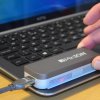The Genome Analysis Centre (TGAC) in Norwich, England has been using a nanopore-sensing technology called the MinION, a product introduced by Oxford Nanopore Technologies Ltd, a U.K.-based startup company. The research team plans to use this miniature device to develop a robust protocol for real-time DNA sequencing in the field in contrast to taking samples back to the laboratory and analyzing them there. The group has already successfully sequenced twenty bacteria samples taken from the environment in real-time. Due to its small size, the device is said to have a large error profile, however, the team has come up with various ways to counteract that weakness.
For example, the scientists have combined the use of MinION and a bioinformatics tool, Kontaminant, to accurately identify species as the DNA is being analyzed by MinION. Furthermore, to address the error profile of the device, researchers at TGAC have also written a program called NanoOK that allows the user to analyze large amounts of data that are collected by the MinION and compare them to reference DNA sequences for even greater accuracy of identification. With these various technologies, the researchers were able to show that not only was this process viable, but also that the samples taken from the environment are able to be analyzed by the MinION and Kontaminant while being run on a low powered computer such as a Raspberry Pi.
The ability to deploy real time monitoring in the field could change agriculture methods and how we look at crop disease outbreaks, as well as human disease epidemics. These are early days, but it looks like a combination of a small low power sequencing device with the correct experimental and computational approaches can spot pathogens,” said Dr Matt Clark, head of the MAP task force and Plant and Microbial Genomics Group Leader at TGAC.
source:Oxford Nanopore Technologies
Nanopore DNA Sequencing and Raspberry Pi Combine for Real-Time Environmental Studies

